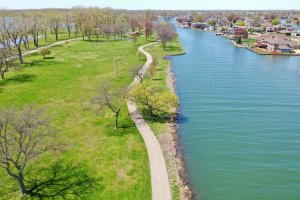Building a Climate Resilient Backyard
August 28, 2023
Erin Parker, Interpretive Services Supervisor
The summer of 2023 has been shattering records for heat1, precipitation2, and even terrible air quality3 thanks to wildfire smoke. News of natural disasters from floods to fires to typhoons dominate our news cycle and our lives. One of the antidotes to the overwhelmingly negative reports on the impacts that climate change is having locally, regionally, and globally is to take action. But even figuring out what individuals can do can feel like a barrier to change. Luckily, in southeast Michigan, we may be particularly well suited to planning for a climate resilient future4. Surrounded by the Great Lakes, we have access to freshwater resources that are unlikely to be inundated with sea level rise and we benefit the from climate moderating effects of large expanses of water which act as buffers to extreme changes in temperature.

Climate resiliency
The concept of climate resiliency is the idea that we can cope with and manage current impacts of climate change while also preventing or reducing future impacts. Climate resilient practices often take place at an agency or institutional level, such as when Huron-Clinton Metroparks considers tree replacement for trees drowned by high water levels or replacing hard-scaped shorelines and parking lots with planted bioswales and living shorelines. It makes more sense to plan for both the current conditions and consider future conditions before we simply replace what used to exist. Our new normal includes more extreme fluctuations of Great Lakes water levels as well as more frequent flooding due to storm intensity. But individuals, families, and communities can take steps to build climate resiliency into their homes and backyards and the best part about these actions is that they also provide aesthetic, health, and even economic benefits along with helping us prepare for current and future climate conditions.
Climate resilient actions
Many of the ways that we address climate change at home include reducing pavement and turf grass (lawn). Both of these surfaces create the potential for runoff and flooding during heavy precipitation events. Many paved surfaces also absorb (and then later reflect) heat from the sun, so during heat waves can add to the high temperatures in and around a home.
Lawn grass can be reduced by planting trees and other long-rooted indigenous plants. These add shade, water filtration, and lessen the need to mow and maintain. Shade provided by trees and tall shrubs can also reduce cooling costs, by keeping indoor spaces cooler. By utilizing plants that are local to southeast Michigan, we can also provide habitat, food, and shelter to a variety of pollinators, birds, and other wildlife.
Another big step that we can take as stewards of our own backyards and community greenspaces, is to consider our soil. Yes, the dirt beneath that lawn grass is really important! Soil stores carbon and water, helps break down organic matter (leaves, garden waste), and supports an entire ecosystem of organisms. Building up the health of our soils can be easy and also helps us reduce the use of expensive fertilizers that wash into our waterways. Soil health can be improved with mulch (those fallen fall leaves are perfect!), compost, and even manure. These materials break down slowly and release important nutrients into the soil. They also improve the structure of soil by increasing air and water holding capacity. Those heavy precipitation events are more easily mitigated when soils are healthy and not compacted, improving the drainage in your backyard or garden.

Compost is another potential climate resiliency step to take! Both traditional compost bins (a mixture of dry and wet non-meat-and-dairy food scraps, grass clippings, dry leaves, etc) and worm bins that rely on red wiggler worms to consume the scraps, often in an indoor worm bin, work to keep potentially methane-producing plant, garden, and kitchen scraps out of landfills. As the compost breaks down into soil, it can be added to gardens and flower beds, furthering boosting the health of the soil.
Benefits of climate resilience at home
The benefits of building in and planning for climate resiliency are many. There are the mental and emotional benefits that happen when we take action, instead of succumbing to the feeling that we can’t do anything to change a situation. Our sense of safety and well-being may improve, because while none of us can control the future, we can plan for and mitigate some of the changes that we are likely to see. We may improve the aesthetics and value of our homes and communities by adding trees, building soil health, and increasing habitat for wildlife. We may even see economic benefits to reducing our garbage (through composting), lowering our heating and cooling bills (strategic planting of trees for shade, reducing our dark-colored, heat-absorbing pavement), and lessening flooding and flood damage (building our soil health, planting local plants and trees, minimizing hard surfaces).
Climate resiliency practices are things that we can all put in place to help our families and communities thrive now and into the future.
Resources for climate resiliency at home
Looking for help to get started?
Sources
